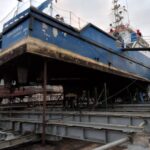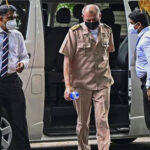It has been over two months since the MV Xpress pearl disaster; however, the story is still in the news despite the fact that disasters in Sri Lanka are usually forgotten within weeks.
By late July 2021, the government’s sole focus seemed to be on obtaining adequate compensation from the MV Xpress Pearl owners and its insurance company. While compensation is vital, the state seems to have forgotten that it still has things to do to minimise the environmental impact and that a lot needs to be done to prevent a repeat of this disaster. Even by 25 July 2021, oil had been leaking from the vessel, polluting one of Sri Lanka’s most important sea areas.
The disaster also showed us how unprepared the country is to become a maritime hub, which has been one of Sri Lanka’s main ambitions for the past few decades. In recent years, successive governments had sunk billions in investments into ports, and due to the constant investments and the country’s strategic location, Colombo Port had become one of Asia’s premier maritime logistics hubs.
However, the MV X-Press Pearl incident laid bare that our Emergency Response fundamentals, i.e. clarity, capacity, coordination, capabilities, competence, and cohesiveness, have a lot to be desired for. Sri Lanka was late to identify that there was a serious problem with the vessel, although ports in Qatar and India had been aware of it; and the subsequent actions of the authorities, from selecting the extinguishing medium to the ambience toxicity mitigation effort, was nothing to write home about. The incident not only caused incalculable losses to the environment and livelihoods but has also put a serious dent in the reputation of the Colombo Port.
While such events are not frequent, the impact is colossal, and the country is likely to increasingly encounter such scenarios as it attempts to attract more ships into its ports. This article will look at the environmental impact, compensation process, and the importance of enhancing our emergency preparedness.
Limits of response
Prior to arriving in Colombo, the MV X-Press Pearl attempted to offload the compromised container at the Hamad Port in Qatar and Hazira Port in Gujarat. Both ports denied the requests. It’s obvious that the disaster at sea could have been avoided had either port offloaded the container. Media reports claim that both ports had stated they lacked the manpower and equipment to discharge the leaking container.
However, as Claudio Bozzi, Lecturer in Law at the Deakin University in Australia stated, it is hard to imagine such recently built, state-of-the-art, and well-resourced facilities lacking the means to deal with a nitric acid leak.
“Ports may be reluctant to accept hazardous vessels because they lack emergency and contingency plans, or preparedness. It is one thing to adopt hazard and environmental policies, but quite another to actually implement them. This would require providing the training and maintaining the necessary equipment to address any potential threats,” he said.
Bozzi added that port services are as competitive as shipping companies, and aim to move the maximum amount of containers through their terminals. This ethos makes the physical investigation of the contents of containers impossible, and any processing delay unaffordable.
He added that the investigation into the X-Press Pearl will reveal if the crew sought a priority berth for shelter while the ship was engulfed in flames at the Colombo Port.
“Arguably, ships in distress have traditionally enjoyed the ‘freedom of ports’ to seek shelter in the territorial waters of nations if they are facing the total loss of the vessel and its cargo or the lives of its crew. But States may deny ships entry if, for instance, they pose a serious threat to the environment or the safety or security of its people. Given the increasing size of vessels and the uncertain nature of the threat they pose, refusal of entry is the norm,” he added.
Bozzi added that in 2003, the International Maritime Organisation (IMO) adopted a resolution creating ‘Places of Refuge’ for vessels in distress. These are sheltered waters, and not ports with the infrastructure to counteract serious problems on board. So while refuge may address the threat of fire, it does not avert the far greater risk of environmental pollution.
“Places of Refuge has assuaged some of the concerns, but they are not an international obligation. They also tend to be concentrated in developed maritime regions and are virtually nonexistent where they are most needed – where substandard vessels carrying illicit and dangerous cargoes ply their trade. It is important we do not let the MV X-Press Pearl settle into the background as another spectacular story about a ship ablaze at sea. It should spark change and serve as the cautionary exemplar of what happens with alarming frequency when we want our goods cheap and now,” he said.
Environmental damage

Fishermen are losing Rs. 80 million a day, and all foreign fish orders, worth around USD 300 million, have been cancelled due to the fallout of the MV X-Press Pearl incident, Executive Director of the Centre for Environmental Justice (CEJ) Hemantha Withanage told Oceanlust. There are serious economic, social, and environmental consequences to this disaster.
The Marine Environment Protection Authority’s (MEPA) initial claim for damages till 1 June was USD 40 million.
“There are 70 -75 billion nurdles (small plastic pellets) on our beaches from the MV X-Press Pearl, and at least 40% of these nurdles will not be taken out of the environment,” Withanage added.
Withanage said that he obtained a list of materials that were included in the 1,486 containers that the ship was carrying. The ship was carrying items such as methanol, lubricants, high and low-density polyethylene, nitric acid, sodium methoxide, and caustic soda (the latter both which can cause fire when mixed with water,) some heavy metals and engine oil, he said.
“81 containers contained toxic materials, including hazardous chemicals. These should have been carried with safety methods, and one container was carrying lithium batteries that were labelled as environmentally hazardous substances,” he said.
Withanage said that the crew had been aware of a leak in a container carrying nitric acid on 11 May 2021, when they were near Qatar, but they had travelled for nine days without addressing the issue. The CEJ Executive Director said that after the fire broke out aboard the ship, almost everyone involved in the rescue operation had used water to douse the fire.
“However, there were containers of sodium methoxide and caustic soda on the ship, and when mixed with water they generate heat that can lead to a fire. No one should have used water at that point. The material data sheet that comes with the container would have warned not to use water and to use dry fire retardants. However, there was an explosion on the 26th and the nurdles started appearing on our beaches the next day,” he said.
The ship was carting 20 containers of high and low-density polyethene, of nurdles that weighed about 20 milligrams each. Given that these nurdles were in 46,960 bags, each weighing about 25 kilos, between 70-75 billion nurdles would have been released to the environment, he said. “Removing nurdles from the beach is a difficult task, and with the methods, we use at least 40% of the nurdles will remain nestled in the sand,” he said.
“Once the nurdles are mixed with sand, it’s hard to get them out. Plastic remains in the water for between 500 and 1,000 years. These will remain on our beaches for centuries, and this is a serious issue. We are finding these nurdles in beaches from Mannar to Rekawa, almost 50% of our coastline. As these nurdles rub up against the sand and interact with salt water, and some of it will become microplastic,” he said.

Withanage said that while the whereabouts of some containers are known, there are about 1,470 containers that are unaccounted for. Most likely these containers are lying among the corals and will start releasing toxins as they interact with the saltwater. As fish swim across these contaminated waters, they will be exposed to them, and for years the fish in the area will contain harmful toxins.
“When the incident with New Diamond occurred, about 20 dead turtles washed ashore. Scientists said that if 20 washed ashore, at least 100 would have died. We have already found the carcasses of 15 dead turtles, which means around 75 of them must have died. Another serious concern is that we are finding dead dolphins. These are intelligent creatures and usually know how to avoid contaminated water. If they are dying it means that the toxins have spread,” Withanage said.
The CEJ Executive Director said that the above factors showed that the ship and its immediate environment are extremely contaminated. Debris from the ship keeps washing ashore, which is hazardous, and the ship itself should be considered a hazardous waste, he said.
“This should not be handled as ordinary waste. We must get these containers out and then we can look at other damages. A lot of research is needed to estimate the impact and the cost. Fishermen are losing Rs. 80 million per day and all foreign fish orders have been cancelled. The loss is estimated at USD 300 million. There are serious economic, social, and environmental consequences to this disaster,” he said.
Emergency preparedness
Sri Lanka’s ports are an important part of its national economy, and a significant percentage of cargo entering the country arrives by ship. Colombo Port, of course, is the country’s largest and most important port. Given the impact that a major shipping accident could have on port operations, environment, national economy and the reputation of the port; it is important that there are processes of formal risk assessment and control measures in place to deal with contingencies.
International Harbour Masters Association (IHMA) stated that it is essential that comprehensive contingency plans are prepared and exercised for all likely scenarios and that these plans must be developed and exercised in collaboration with emergency responders including the Police, fire, and ambulance, and with local authorities and environmental regulators. IHMA adds that when a port has to deal with a ship in distress; they should be placed in an area of sheltered water where the situation can be stabilised, the cargo made safe, and the salvors and authorities can evaluate what further steps are necessary in a timely manner.
“Failure to offer a suitable place of refuge may prevent successful salvage intervention, and therefore allow a casualty’s condition to worsen and ultimately lead to pollution that might otherwise have been prevented. IHMA considers that the decision to grant access to a place of refuge can only be taken on a case-by-case basis. The decision must be based on a properly argued and evidenced technical case, and include a comparison between the risks involved if the ship remains at sea and the risks it would pose to the place of refuge and its environment,” IHMA stated.
The road ahead
The sinking of the ship and its aftereffects will directly impact harbours on the Western coast, where thousands of fishermen engage in offshore fishing, nearshore fishing, and lagoon fishing. The Dikkowita Fishing Harbour is less than 10 kilometres from the site and about 349 boats, 272 rafters, and 33 multi-day boats operate out of this harbour. Over 6,000 fishermen operate out from the Uswetakeiyawa to Negombo coastal stretch. Meanwhile, the Negombo lagoon has 3,000 fishermen, and 1,300 boats and fishing crafts. Although the government had decided to provide them with an allowance of Rs. 5,000, this is not at all adequate to compensate for the loss of likelihoods.
Given the scale of the incident, the government must ensure that the ship operator compensates for the massive environmental, social, and economic impact. The disaster could have been avoided if the crew and company had acted more responsibly. Polluters and responsible parties for the incident must pay for the damage caused to the territorial sea and its ocean life, water quality, air quality and other interests such as damage to livelihoods and fisheries.
Under the polluter pays principle, polluters and responsible parties are required to pay for the damage they cause to the territorial sea and its ocean life, water quality, air quality and other interests such as damage to livelihoods and fisheries in addition to the cost of emergency response, cleanups and compensation to the victims of pollution. However, as environmentalists claim, Sri Lankan governments have not handled such issues well in the past. Regarding the 2020 New Diamond incident, Sri Lankan authorities filed charges against the captain of the ship and claimed USD 2.4 million from the ship’s owners for firefighting and pollution prevention efforts. Those tasked with assessing the environmental damage calculated the damage at around USD 17.38 million. However, this has not yet been paid.
Given that Sri Lanka will have to live with the fallout of the accident for decades to come, Sri Lanka must learn from this disaster and improve its emergency response mechanism. We should also sign important agreements such as the Hazardous and Noxious Substances Convention and incorporate it into the domestic law, which would place us in a better position to claim compensation for the damage done.
As the CEJ Executive Director said, “Scientific decision making should be respected and scientific bodies such as the National Aquatic Resources Agency (NARA) should be given necessary infrastructure and facilities, including a research ship to study our ocean, to bring the benefits of science to prevent future disasters.”
Therefore, “what is the road ahead for Sri Lanka?” is the most important question to answer. What seems to be the most obvious is that there is a need to link and coordinate all government institutions and organisations in charge of maritime activities. From the beginning of the crisis, it was obvious that there was little coordination between these institutions, and that different entities had different objectives, which did not come together to create a coherent whole.
It was also obvious that Sri Lankan institutions, entrusted with dealing with certain aspects of handling the disaster, didn’t have the necessary capacity and experience to do well the job entrusted to them. The Director-General of Merchant Shipping is the overall authority in charge and has vested some duties with the Navy. While the Navy worked extremely hard to douse the fire, it was also obvious that it doesn’t have the firefighting capacity, although it has the manpower.
The need to strengthen the Coast Guard was also obvious in the disaster. The Indian coast guard, which came to our assistance during the crisis, has excellent fire fighting capacity as well as the capacity to scan for underwater debris and deal with marine spills and environment protection. Given that firefighting and salvaging are the key capabilities of coast guards of most maritime nations, it is key that the Sri Lankan coast guard also develops these. Currently, the Coast Guard comes under the defence ministry and thus there is a reluctance by certain international organisations to support it. Therefore, the government should explore the possibility of making the Coast Guard a separate institution and perhaps bring the Marine Environment Protection Authority (MEPA) under the coast guard.
There must also be a vessel management system that uses advanced technology to monitor and manage vehicular traffic in the territorial waters, which should also come under the coast guard.
As suggested by many environmentalists and shipping experts, Sri Lanka needs a national maritime policy and needs to be a part of international maritime cooperation treaties. Not only does this place us in a better position vis a vis compensation, but it will also allow us to link our neighbours better to prevent such accidents from taking place.
Sri Lanka is situated in a strategic location, close to important sea routes. Successive governments have recognised this and have pumped in billions to make Sri Lanka a maritime hub. However, as the MV X-Press Pearl disaster this year and the MV New Diamond disaster last year showed us, Sri Lanka has not put in place the necessary systems to deal with maritime emergencies. Given that Sri Lanka will face increasing numbers of maritime accidents if the strategy to attract more ships succeeds, Sri Lanka needs to put the systems in place and make the necessary links with other nations to make it a maritime hub of the world.






Leave a Reply